Novel Fluoroquinolones with Possible Antibacterial Activity in Gram-Negative Resistant Pathogens: In Silico Drug Discovery
Abstract
1. Introduction
2. Results
2.1. Conformation Analyses of New Fluoroquinolones
2.2. Molecular Docking
2.3. Molecular Dynamics Simulations
2.4. Toxicity Prediction
2.5. Lipinski’s Five Rules
3. Discussion
4. Materials and Methods
4.1. Preparation of Ligands
4.2. Retrieval of DNA Gyrase Structures
4.3. Preparation of Molecular Systems
4.4. Molecular Docking
4.5. Molecular Dynamics Simulations
4.6. Toxicity in Silico Prediction
4.7. Lipinski’s Five Rule Estimation
5. Conclusions
Author Contributions
Funding
Institutional Review Board Statement
Informed Consent Statement
Data Availability Statement
Acknowledgments
Conflicts of Interest
Sample Availability
References
- OMS. Resistencia a Los Antibióticos. Available online: http://www.who.int/es/news-room/fact-sheets/detail/resistencia-a-los-antibióticos (accessed on 20 February 2023).
- O’Neill, J. Tackling Drug-Resistant Infections Globally: Final Report and Recommendations. Available online: https://apo.org.au/node/63983 (accessed on 3 March 2023).
- Murray, C.J.L.; Ikuta, K.S.; Sharara, F.; Swetschinski, L.; Aguilar, G.R.; Gray, A.; Han, C.; Bisignano, C.; Rao, P.; Wool, E.; et al. Global Burden of Bacterial Antimicrobial Resistance in 2019: A Systematic Analysis. Lancet 2022, 339, 629–655. [Google Scholar] [CrossRef] [PubMed]
- Fariña, N. Resistencia Bacteriana: Un Problema de Salud Pública Mundial de Difícil Solución. Mem. Inst. Investig. Cienc. Salud 2016, 14, 4–5. [Google Scholar] [CrossRef]
- Serwecińska, L. Antimicrobials and Antibiotic-Resistant Bacteria: A Risk to the Environment and to Public Health. Water 2020, 12, 3313. [Google Scholar] [CrossRef]
- OMS. La OMS Publica La Lista de Las Bacterias Para Las Que Se Necesitan Urgentemente Nuevos Antibióticos. Available online: https://www.who.int/es/news/item/27-02-2017-who-publishes-list-of-bacteria-for-which-new-antibiotics-are-urgently-needed (accessed on 25 February 2023).
- Mohammed Ali, H. In-Silico Investigation of a Novel Inhibitors against the Antibiotic-Resistant Neisseria Gonorrhoeae Bacteria. Saudi J. Biol. Sci. 2022, 29, 103424. [Google Scholar] [CrossRef]
- Alhadrami, H.A.; Abdulaal, W.H.; Hassan, H.M.; Alhakamy, N.A.; Sayed, A.M. In Silico-Based Discovery of Natural Anthraquinones with Potential against Multidrug-Resistant E. Coli. Pharmaceuticals 2022, 15, 86. [Google Scholar] [CrossRef]
- Mathpal, S.; Joshi, T.; Sharma, P.; Pande, V.; Chandra, S. Assessment of Activity of Chalcone Compounds as Inhibitors of 3-Chymotrypsin like Protease (3CLPro) of SARS-CoV-2: In Silico Study. Struct. Chem. 2022, 33, 1815. [Google Scholar] [CrossRef]
- Breijyeh, Z.; Karaman, R. Design and Synthesis of Novel Antimicrobial Agents. Antibiotics 2023, 12, 628. [Google Scholar] [CrossRef]
- Mohammed, H.H.H.; Abuo-Rahma, G.E.-D.A.A.; Abbas, S.H.; Abdelhafez, E.-S.M.N. Current Trends and Future Directions of Fluoroquinolones. Curr. Med. Chem. 2019, 26, 3132–3149. [Google Scholar] [CrossRef]
- Brar, R.K.; Jyoti, U.; Patil, R.K.; Patil, H.C. Fluoroquinolone Antibiotics: An Overview. Adesh Univ. J. Med. Sci. Res. 2020, 2, 26–30. [Google Scholar] [CrossRef]
- Pham, T.D.M.; Ziora, Z.M.; Blaskovich, M.A.T. Quinolone Antibiotics. Med. Chem. Commun. 2019, 10, 1719–1739. [Google Scholar] [CrossRef]
- Arés, F.; Martínez de la Ossa, R.; Alfayate, S. Quinolonas En Pediatría. Rev. Pediatría Atención Primaria 2017, 19, e83–e92. [Google Scholar]
- Serra, H.A. Quinolonas. Separata 2008, 16, 1–9. [Google Scholar]
- Heddle, J.G.; Barnard, F.M.; Wentzell, L.M.; Maxwell, A. The Interaction of Drugs with DNA Gyrase: A Model for the Molecular Basis of Quinolone Action. Nucleosides, Nucleotides and Nucleic Acids 2000, 19, 1249–1264. [Google Scholar] [CrossRef] [PubMed]
- Khan, T.; Sankhe, K.; Suvarna, V.; Sherje, A.; Patel, K.; Dravyakar, B. DNA Gyrase Inhibitors: Progress and Synthesis of Potent Compounds as Antibacterial Agents. Biomed. Pharmacother. 2018, 103, 923–938. [Google Scholar] [CrossRef] [PubMed]
- Bakken, J.S. The Fluoroquinolones: How Long Will Their Utility Last? Scand. J. Infect. Dis. 2004, 36, 85–92. [Google Scholar] [CrossRef]
- Álvarez, D.A.; Garza, G.S.; Vázquez, R. Quinolonas. Perspectivas Actuales y Mecanismos de Resistencia. Rev. Chil. Infectol. 2015, 32, 499–504. [Google Scholar] [CrossRef]
- Jacho, M. Métodos Computacionales Para El Diseño de Fluoroquinolonas Con Alta Afinidad Por Topoisomerasa II de Leishmania. Bachelor’s Thesis, Universidad Central del Ecuador, Quito, Ecuador, 2020. [Google Scholar]
- Chinemerem Nwobodo, D.; Ugwu, M.C.; Oliseloke Anie, C.; Al-Ouqaili, M.T.S.; Chinedu Ikem, J.; Victor Chigozie, U.; Saki, M. Antibiotic Resistance: The Challenges and Some Emerging Strategies for Tackling a Global Menace. J. Clin. Lab. Anal. 2022, 36, e24655. [Google Scholar] [CrossRef]
- WHO. WHO Antibiotic Categorization. Available online: https://aware.essentialmeds.org/groups (accessed on 2 April 2023).
- ONU. La Incapacidad Para Fabricar Antibióticos Nuevos Favorece La Resistencia de Las Bacterias a Los Medicamentos. Available online: https://news.un.org/es/story/2021/04/1490872 (accessed on 5 March 2023).
- Ballón, W.; Grados, R. Acomplamiento Molecular: Criterios Prácticos Para La Selección de Ligandos Biológicamente Activos e Identificación de Nuevos Blancos Terapéuticos. Rev. Con-Ciencia 2019, 7, 55–72. [Google Scholar]
- Shaker, B.; Ahmad, S.; Lee, J.; Jung, C.; Na, D. In Silico Methods and Tools for Drug Discovery. Comput. Biol. Med. 2021, 137, 104851. [Google Scholar] [CrossRef]
- Madurga, S.; Sánchez, J.; Belda, I.; Vila, J.; Giralt, E. Mechanism of Binding of Fluoroquinolones to the Quinolone Resistance-Determining Region of DNA Gyrase: Towards an Understanding of the Molecular Basis of Quinolone Resistance. ChemBioChem 2008, 9, 2081–2086. [Google Scholar] [CrossRef]
- Cramariuc, O.; Rog, T.; Javanainen, M.; Monticelli, L.; Polishchuk, A.V.; Vattulainen, I. Mechanism for Translocation of Fluoroquinolones across Lipid Membranes. Biochim. Biophys. Acta Biomembr. 2012, 1818, 2563–2571. [Google Scholar] [CrossRef] [PubMed]
- Kibwana, U.O.; Manyahi, J.; Sandnes, H.H.; Blomberg, B.; Mshana, S.E.; Langeland, N.; Roberts, A.P.; Moyo, S.J. Fluoroquinolone Resistance among Fecal Extended Spectrum Βeta Lactamases Positive Enterobacterales Isolates from Children in Dar Es Salaam, Tanzania. BMC Infect. Dis. 2023, 23, 135. [Google Scholar] [CrossRef] [PubMed]
- Zhang, D.; Cui, Y.; Zhang, X. Estimating Factors Related to Fluoroquinolone Resistance Based on One Health Perspective: Static and Dynamic Panel Data Analyses from Europe. Front. Pharmacol. 2019, 10, 1145. [Google Scholar] [CrossRef] [PubMed]
- Deku, J.G.; Duedu, K.O.; Ativi, E.; Kpene, G.E.; Feglo, P.K. Burden of Fluoroquinolone Resistance in Clinical Isolates of Escherichia Coli at the Ho Teaching Hospital, Ghana. Ethiop. J. Health Sci. 2022, 32, 93. [Google Scholar] [CrossRef]
- Rath, S.; Padhy, R.N. Prevalence of Fluoroquinolone Resistance in Escherichia Coli in an Indian Teaching Hospital and Adjoining Communities. J. Taibah Univ. Med. Sci. 2015, 10, 504–508. [Google Scholar] [CrossRef][Green Version]
- Huang, H.W.; Liu, H.Y.; Chuang, H.C.; Chen, B.L.; Wang, E.Y.; Tsao, L.H.; Ai, M.Y.; Lee, Y.J. Correlation between Antibiotic Consumption and Resistance of Pseudomonas Aeruginosa in a Teaching Hospital Implementing an Antimicrobial Stewardship Program: A Longitudinal Observational Study. J. Microbiol. Immunol. Infect. 2023, 56, 337–343. [Google Scholar] [CrossRef]
- Donkor, E.S.; Muhsen, K.; Johnson, S.A.M.; Kotey, F.C.N.; Dayie, N.T.K.D.; Tetteh-Quarcoo, P.B.; Tette, E.M.A.; Osei, M.M.; Egyir, B.; Nii-Trebi, N.I.; et al. Multicenter Surveillance of Antimicrobial Resistance among Gram-Negative Bacteria Isolated from Bloodstream Infections in Ghana. Antibiotics 2023, 12, 255. [Google Scholar] [CrossRef]
- Orero, A.; Cantón, E.; Pemán, J.; Gobernado, M. Penetración de Los Antibióticos de Los Polimorfonucleares Humanos, Con Especial Referencia a Las Quinolonas. Rev. Española Quimioter. 2002, 15, 129–140. [Google Scholar]
- Yamauchi, S.; Sugano, K. Permeation Characteristics of Tetracyclines in Parallel Artificial Membrane Permeation Assay. ADMET DMPK 2019, 7, 151. [Google Scholar] [CrossRef]
- Hermann, K.F.; Neuhaus, C.S.; Micallef, V.; Wagner, B.; Hatibovic, M.; Aschmann, H.E.; Paech, F.; Alvarez-Sanchez, R.; Krämer, S.D.; Belli, S. Kinetics of Lipid Bilayer Permeation of a Series of Ionisable Drugs and Their Correlation with Human Transporter-Independent Intestinal Permeability. Eur. J. Pharm. Sci. 2017, 104, 150–161. [Google Scholar] [CrossRef]
- Tam, K.Y.; Avdeef, A.; Tsinman, O.; Sun, N. The Permeation of Amphoteric Drugs through Artificial Membranes--an in Combo Absorption Model Based on Paracellular and Transmembrane Permeability. J. Med. Chem. 2010, 53, 392–401. [Google Scholar] [CrossRef] [PubMed]
- Norouzbahari, M.; Salarinejad, S.; Güran, M.; Şanlıtürk, G.; Emamgholipour, Z.; Bijanzadeh, H.R.; Toolabi, M.; Foroumadi, A. Design, Synthesis, Molecular Docking Study, and Antibacterial Evaluation of Some New Fluoroquinolone Analogues Bearing a Quinazolinone Moiety. DARU, J. Pharm. Sci. 2020, 28, 661–672. [Google Scholar] [CrossRef] [PubMed]
- Davila, C.; Llach, L.; Salgado-Moran, G.; Ramirez-Tagle, R. Docking Studies on Novel Analogs of Quinolones against DNA Gyrase of Escherichia Coli. J. Pharm. Pharmacogn. Res. 2018, 6, 386–391. [Google Scholar]
- Wang, E.; Sun, H.; Wang, J.; Wang, Z.; Liu, H.; Zhang, J.Z.H.; Hou, T. End-Point Binding Free Energy Calculation with MM/PBSA and MM/GBSA: Strategies and Applications in Drug Design. Chem. Rev. 2019, 119, 9478–9508. [Google Scholar] [CrossRef] [PubMed]
- Hou, Y.; Zhao, Y.; Li, Y. Environmentally Friendly Fluoroquinolone Derivatives with Lower Plasma Protein Binding Rate Designed Using 3D-QSAR, Molecular Docking and Molecular Dynamics Simulation. Int. J. Environ. Res. Public Health 2020, 17, 6626. [Google Scholar] [CrossRef]
- Pantsar, T.; Poso, A. Binding Affinity via Docking: Fact and Fiction. Molecules 2018, 23, 1899. [Google Scholar] [CrossRef] [PubMed]
- Huang, X.; Guo, J.; Liu, Q.; Gu, Q.; Xu, J.; Zhou, H. Identification of an Auxiliary Druggable Pocket in the DNA Gyrase ATPase Domain Using Fragment Probes. Med. Chem. Commun. 2018, 9, 1619–1629. [Google Scholar] [CrossRef]
- Susanta, S.; Surendra, P.; Ashish, P. In-Silico Identification and Molecular Docking Studies of Quinolone Resistance Determining Region (QRDR) of E.Coli DNA Gyrase-a with Ofloxacin Schiff Bases. Int. J. PharmTech Res. 2013, 5, 1794–1803. [Google Scholar]
- Hanwell, M.; Curtis, D.; Lonie, D.; Vandermeersch, T.; Zurek, E.; Hutchison, G. Avogadro: An Advanced Semantic Chemical Editor, Visualization, and Analysis Platform. J. Cheminform. 2012, 4, 17. [Google Scholar] [CrossRef]
- ChemAxon. MarvinSketch (Version 21.12.0). Available online: https://chemaxon.com/marvin (accessed on 2 September 2022).
- Frisch, M.J.; Trucks, G.W.; Schlegel, H.B.; Scuseria, G.E.; Robb, M.A.; Cheeseman, J.R.; Scalmani, G.; Barone, V.; Mennucci, B.; Petersson, G.A.; et al. Gaussian09. Revision D01; Gaussian, Inc.: Wallingford, CT, USA, 2009. [Google Scholar]
- Bax, B.D.; Chan, P.F.; Eggleston, D.S.; Fosberry, A.; Gentry, D.R.; Gorrec, F.; Giordano, I.; Hann, M.M.; Hennessy, A.; Hibbs, M.; et al. Type IIA Topoisomerase Inhibition by a New Class of Antibacterial Agents. Nature 2010, 466, 935–940. [Google Scholar] [CrossRef]
- Berman, H.; Henrick, K.; Nakamura, H. Announcing the Worldwide Protein Data Bank. Nat. Struct. Biol. 2003, 10, 980. [Google Scholar] [CrossRef] [PubMed]
- Bateman, A.; Martin, M.J.; Orchard, S.; Magrane, M.; Ahmad, S.; Alpi, E.; Bowler-Barnett, E.H.; Britto, R.; Bye-A-Jee, H.; Cukura, A.; et al. UniProt: The Universal Protein Knowledgebase in 2023. Nucleic Acids Res. 2023, 51, D523–D531. [Google Scholar] [CrossRef]
- Da Silva, B.; Medeiros, V.; Barbosa, A.V.; Silva, W.; Faccini, F.; Lima da Costa, D.; Clementino, M.; Cosendey, M. Detection of Fluoroquinolone Resistance by Mutation in GyrA Gene of Campylobacter Spp. Isolates from Broiler and Laying (Gallus Gallus Domesticus) Hens, from Rio de Janeiro State, Brazil. Ciência Rural 2015, 45, 2013–2018. [Google Scholar] [CrossRef]
- Varughese, L.R.; Rajpoot, M.; Goyal, S.; Mehra, R.; Chhokar, V.; Beniwal, V. Analytical Profiling of Mutations in Quinolone Resistance Determining Region of GyrA Gene among UPEC. PLoS ONE 2018, 13, e0190729. [Google Scholar] [CrossRef] [PubMed]
- Kivata, M.W.; Mbuchi, M.; Eyase, F.L.; Bulimo, W.D.; Kyanya, C.K.; Oundo, V.; Muriithi, S.W.; Andagalu, B.; Mbinda, W.M.; Soge, O.O.; et al. GyrA and ParC Mutations in Fluoroquinolone-Resistant Neisseria Gonorrhoeae Isolates from Kenya. BMC Microbiol. 2019, 19, 76. [Google Scholar] [CrossRef]
- Zhao, L.; Wang, S.; Li, X.; He, X.; Jian, L. Development of in Vitro Resistance to Fluoroquinolones in Pseudomonas Aeruginosa. Antimicrob. Resist. Infect. Control 2020, 9, 124. [Google Scholar] [CrossRef]
- Britto, C.D.; Dyson, Z.A.; Mathias, S.; Bosco, A.; Dougan, G.; Jose, S.; Nagaraj, S.; Holt, K.E.; Pollard, A.J. Persistent Circulation of a Fluoroquinolone-Resistant Salmonella Enterica Typhi Clone in the Indian Subcontinent. J. Antimicrob. Chemother. 2020, 75, 337–341. [Google Scholar] [CrossRef]
- Pettersen, E.F.; Goddard, T.D.; Huang, C.C.; Couch, G.S.; Greenblatt, D.M.; Meng, E.C.; Ferrin, T.E. UCSF Chimera - A Visualization System for Exploratory Research and Analysis. J. Comput. Chem. 2004, 25, 1605–1612. [Google Scholar] [CrossRef]
- McGann, M. FRED and HYBRID Docking Performance on Standardized Datasets. J. Comput. Aided. Mol. Des. 2012, 26, 897–906. [Google Scholar] [CrossRef]
- Hawkins, P.C.D.; Skillman, A.G.; Warren, G.L.; Ellingson, B.A.; Stahl, M.T. Conformer Generation with OMEGA: Algorithm and Validation Using High Quality Structures from the Protein Databank and Cambridge Structural Database. J. Chem. Inf. Model. 2010, 50, 572–584. [Google Scholar] [CrossRef]
- The PyMOL Molecular Graphics System v.1.3. Schrödinger, LLC. Available online: https://www.pymol.org/pymol (accessed on 20 September 2022).
- Phillips, J.C.; Schulten, K.; Bhatele, A.; Mei, C.; Sun, Y.; Bohm, E.J.; Kale, L.V. Scalable Molecular Dynamics with NAMD. J. Comput. Chem. 2005, 26, 1781–1802. [Google Scholar] [CrossRef]
- Maier, J.A.; Martinez, C.; Kasavajhala, K.; Wickstrom, L.; Hauser, K.E.; Simmerling, C. Ff14SB: Improving the Accuracy of Protein Side Chain and Backbone Parameters from Ff99SB. J. Chem. Theory Comput. 2015, 11, 3696–3713. [Google Scholar] [CrossRef] [PubMed]
- Galindo-Murillo, R.; Robertson, J.C.; Zgarbová, M.; Šponer, J.; Otyepka, M.; Jurečka, P.; Cheatham, T.E. Assessing the Current State of Amber Force Field Modifications for DNA. J. Chem. Theory Comput. 2016, 12, 4114–4127. [Google Scholar] [CrossRef] [PubMed]
- Wang, J.; Wolf, R.M.; Caldwell, J.W.; Kollman, P.A.; Case, D.A. Development and Testing of a General Amber Force Field. J. Comput. Chem. 2004, 25, 1157–1174. [Google Scholar] [CrossRef] [PubMed]
- Case, D.A.; Aktulga, H.M.; Belfon, K.; Ben-Shalom, I.Y.; Berryman, J.T.; Brozell, S.R.; Cerutti, D.S.; T.E. Cheatham, I.; Cisneros, G.A.; Cruzeiro, V.W.D.; et al. Amber 2022; University of California: San Francisco, CA, USA, 2022.
- Miller, B.R.; McGee, T.D.; Swails, J.M.; Homeyer, N.; Gohlke, H.; Roitberg, A.E. MMPBSA.Py: An Efficient Program for End-State Free Energy Calculations. J. Chem. Theory Comput. 2012, 8, 3314–3321. [Google Scholar] [CrossRef]
- Banerjee, P.; Eckert, A.O.; Schrey, A.K.; Preissner, R. ProTox-II: A Webserver for the Prediction of Toxicity of Chemicals. Nucleic Acids Res. 2018, 46, W257–W263. [Google Scholar] [CrossRef]
- Daina, A.; Michielin, O.; Zoete, V. SwissADME: A Free Web Tool to Evaluate Pharmacokinetics, Drug-Likeness and Medicinal Chemistry Friendliness of Small Molecules. Sci. Rep. 2017, 7, 42717. [Google Scholar] [CrossRef]
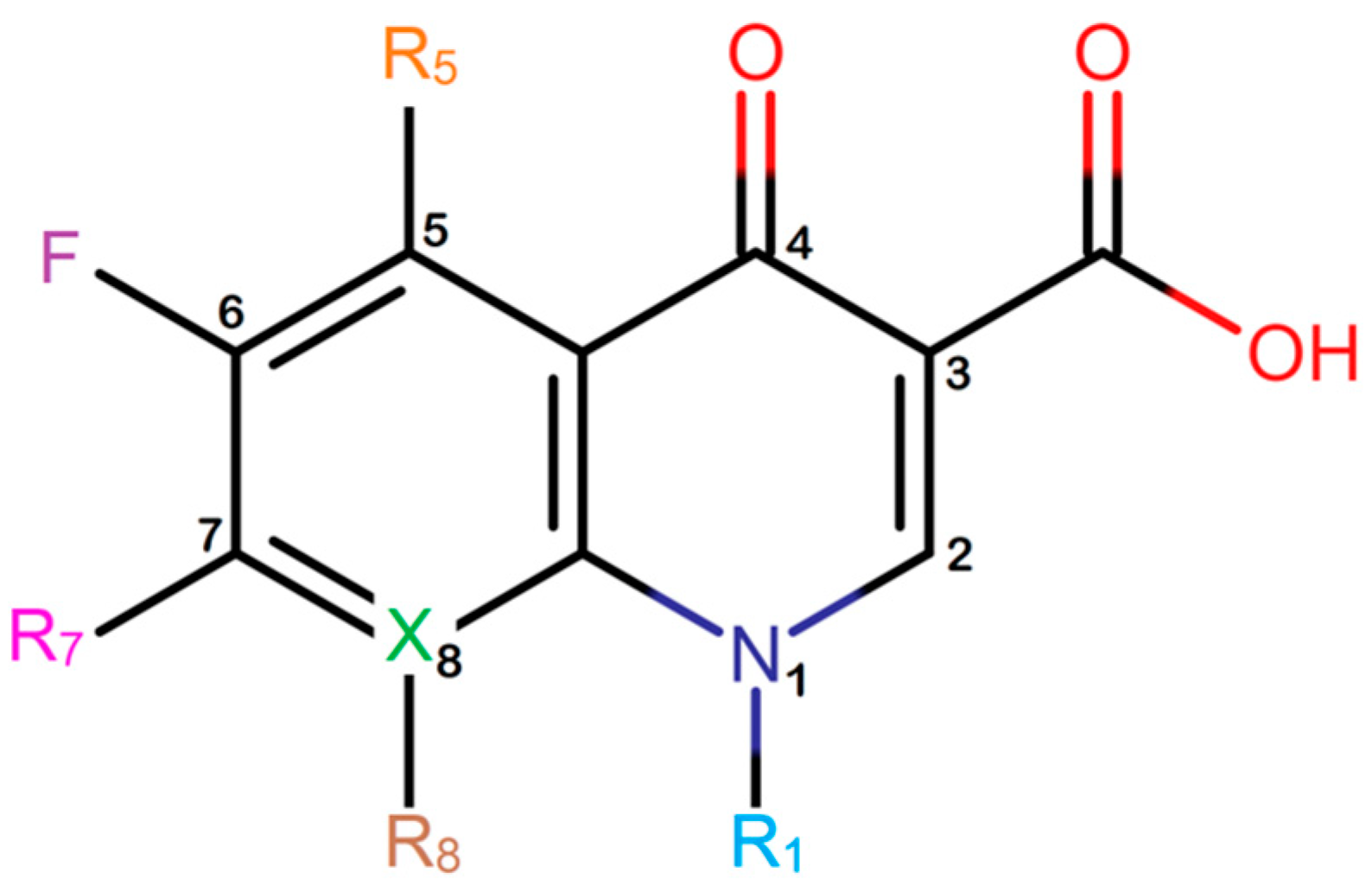
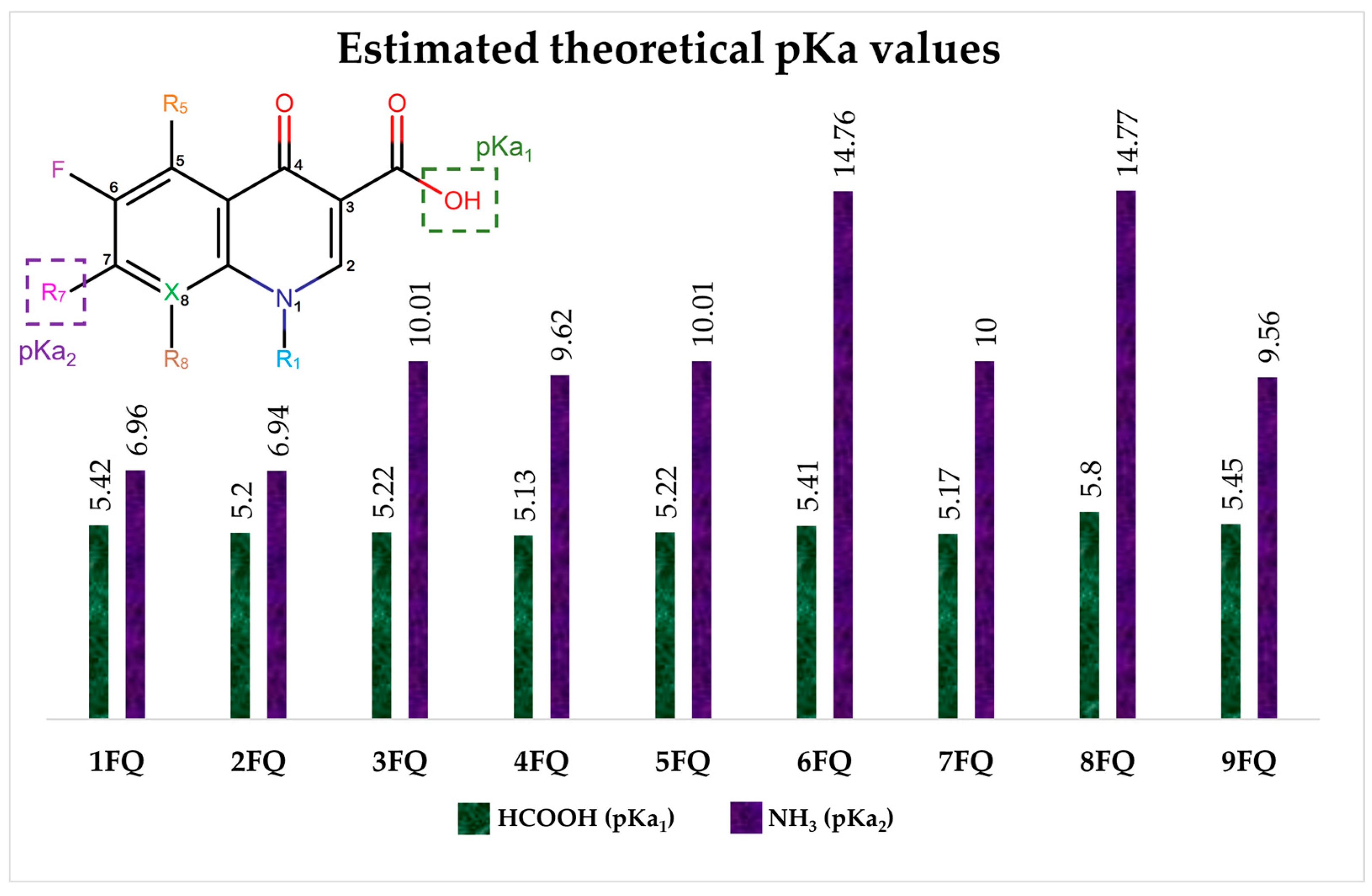
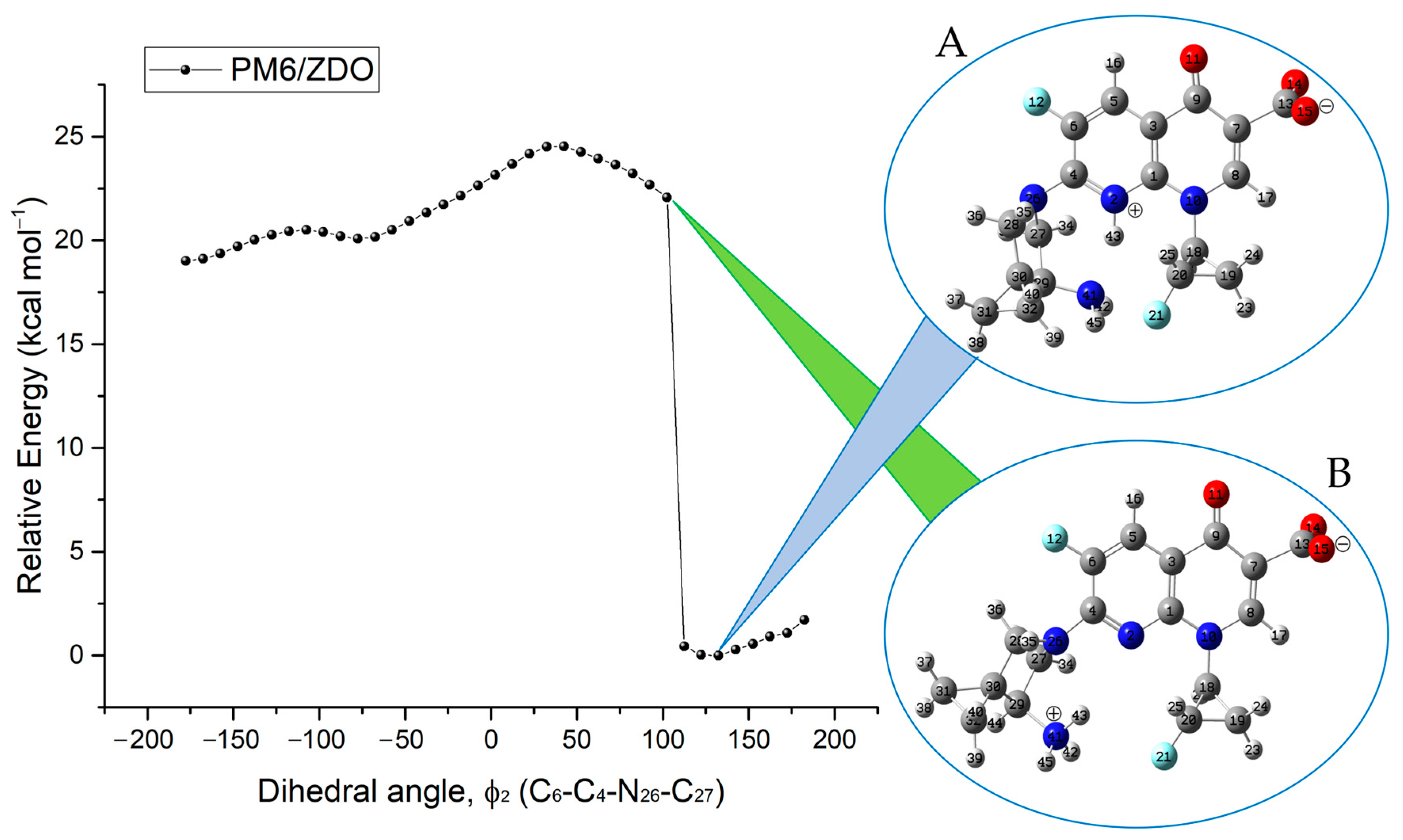

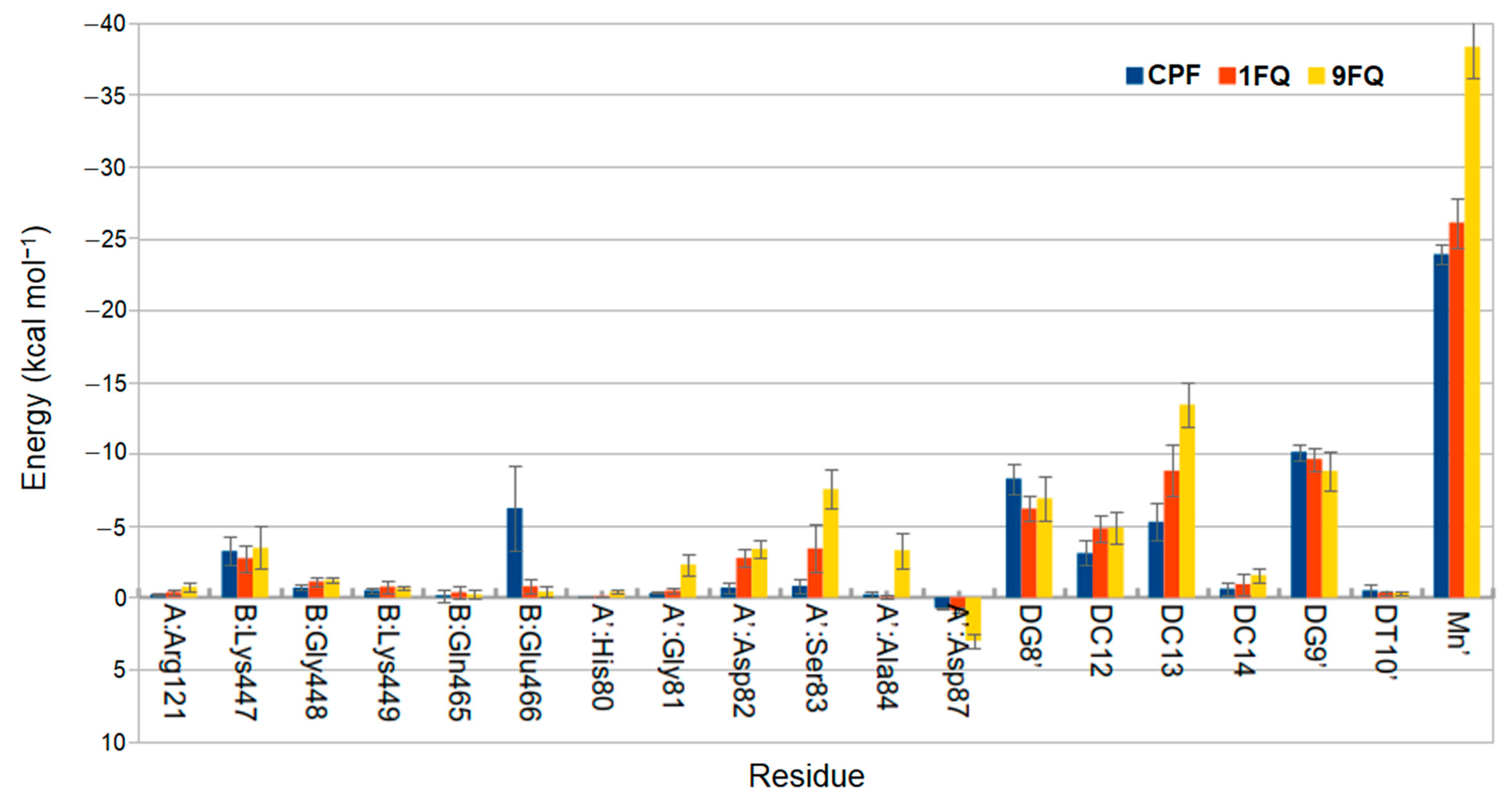
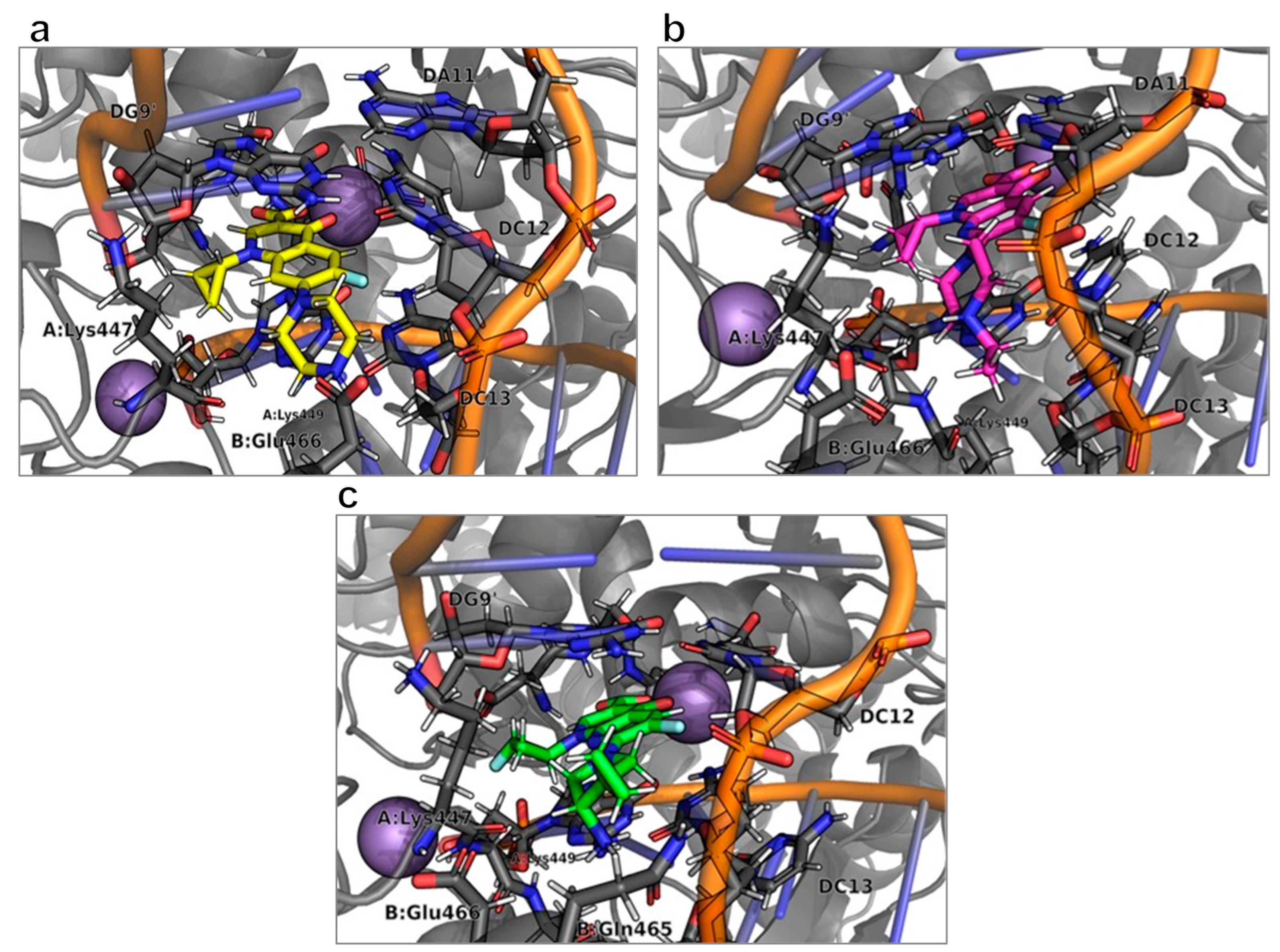
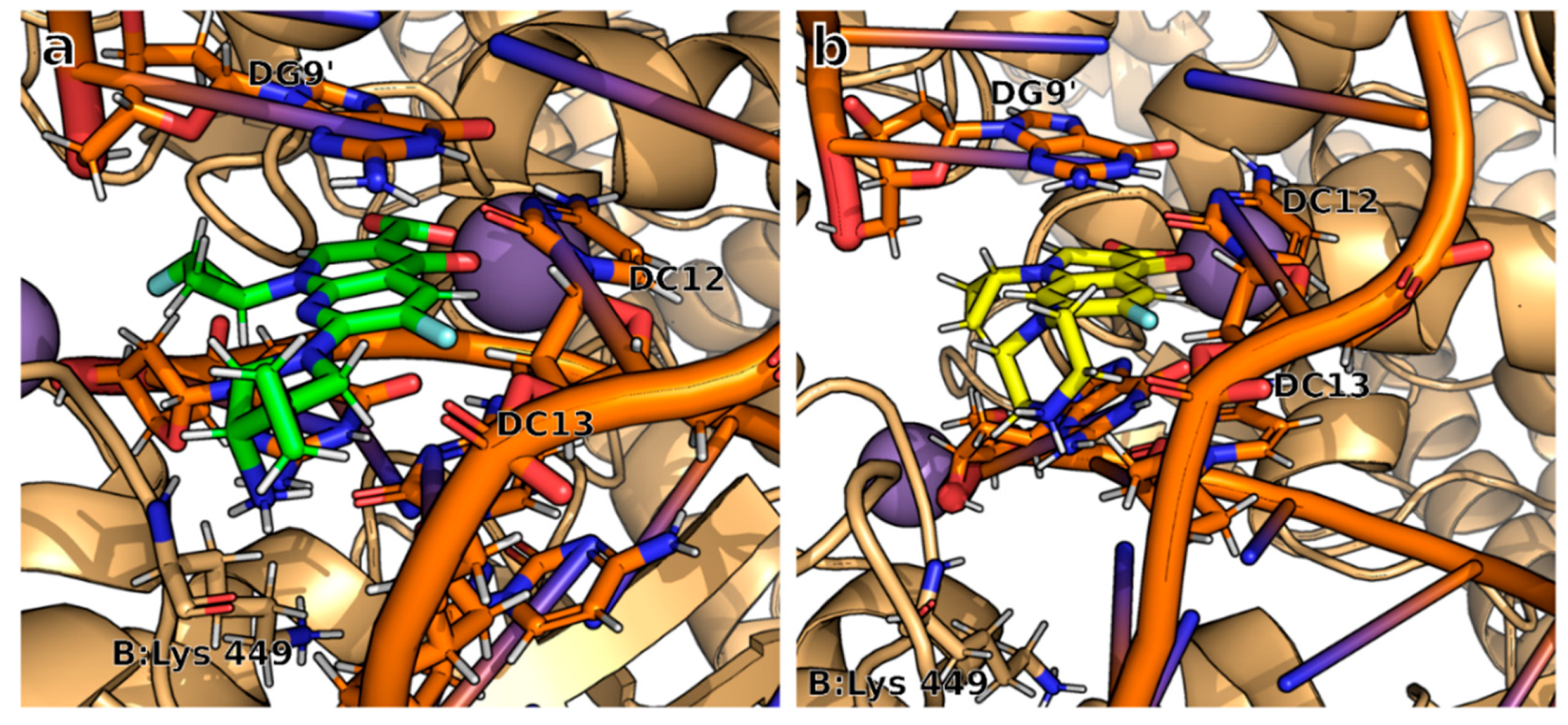



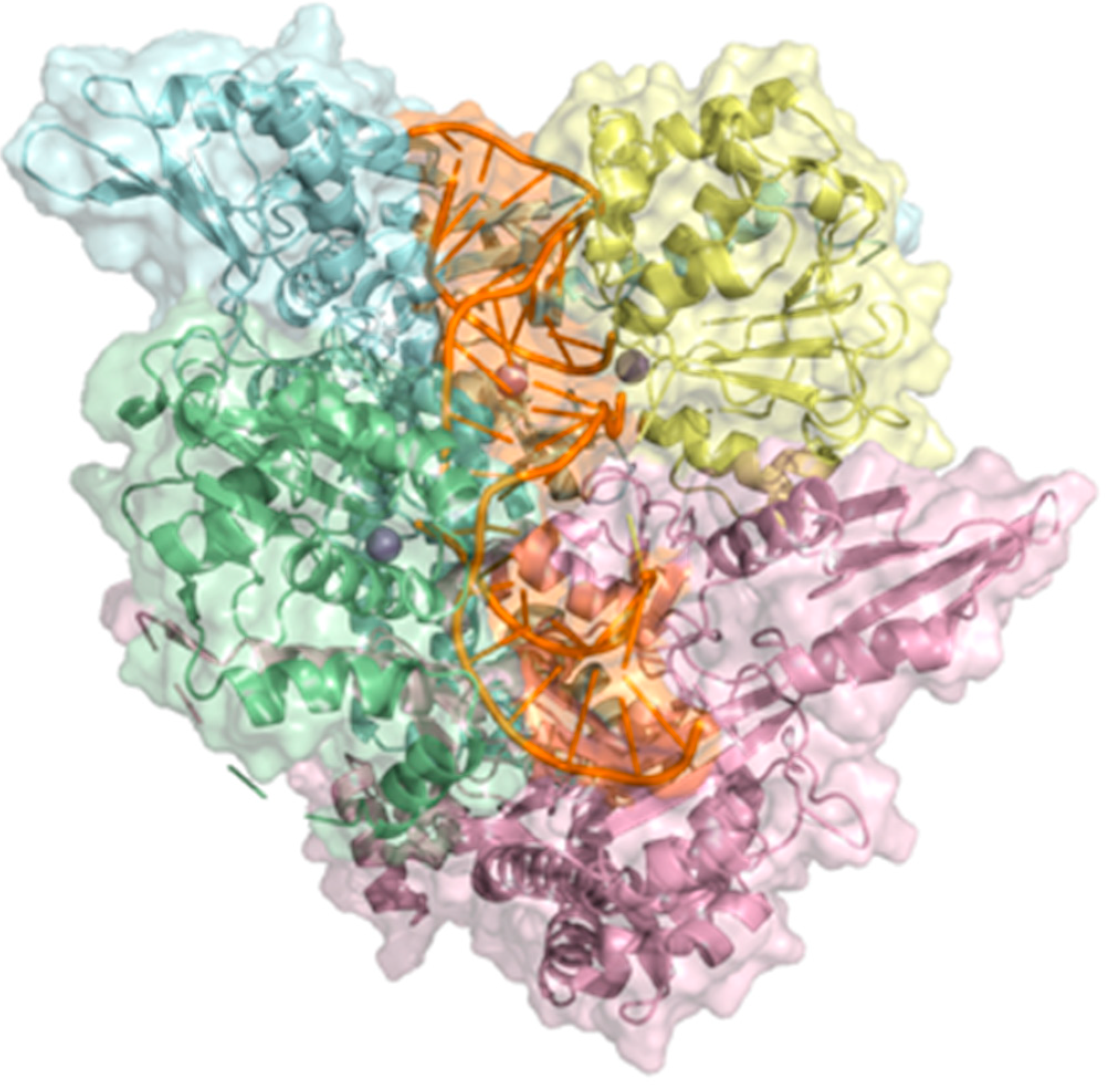
| Ligand | DNA Gyrase | |||||||
|---|---|---|---|---|---|---|---|---|
| Binding Energy Score (kcal/mol) | ||||||||
| E. coli | P. aeruginosa | C. jejuni | S. typhi | N. gonorrhoeae | ||||
| WT | MT | WT | MT | WT | MT | MT | MT | |
| 1FQ | −13.6 | −14.0 | −13.5 | −13.5 | −14.4 | −13.6 | −14.2 | −13.7 |
| 2FQ | −8.7 | −9.0 | −8.7 | −8.8 | −8.0 | −7.4 | −9.9 | −8.7 |
| 3FQ | −11.6 | −10.1 | −12.4 | −10.3 | −10.7 | −10.4 | −11.9 | −11.6 |
| 4FQ | −11.6 | −12.2 | −11.6 | −11.6 | −11.2 | −9.7 | −12.9 | −11.7 |
| 5FQ | −11.8 | −12.0 | −11.5 | −11.4 | −12.0 | −11.7 | −12.6 | −11.8 |
| 6FQ | −10.9 | −11.0 | −10.6 | −10.6 | −11.1 | −10.6 | −11.5 | −11.2 |
| 7FQ | −10.7 | −10.8 | −10.4 | −10.5 | −11.1 | −10.6 | −11.4 | −10.8 |
| 8FQ | −12.0 | −11.6 | −11.2 | −11.1 | −12.0 | −11.2 | −12.0 | −12.2 |
| 9FQ | −14.4 | −13.6 | −13.6 | −13.5 | −14.2 | −13.0 | −14.4 | −14.3 |
| CPF | −12.0 | −12.0 | −11.5 | −11.5 | −12.1 | −10.9 | −12.4 | −12.0 |
| OFX | −9.6 | −9.2 | −9.4 | −9.4 | −10.3 | −9.0 | −10.0 | −9.8 |
| LEV | −10.5 | −10.0 | −9.6 | −9.6 | −10.0 | −9.0 | −10.3 | −10.6 |
| NOR | −11.7 | −11.7 | −11.3 | −11.3 | −11.9 | −11.5 | −12.0 | −11.9 |
| Ligand | Binding Energy (kcal·mol−1) |
|---|---|
| 1FQ | −40.1 ± 4.0 |
| 9FQ | −45.2 ± 4.8 |
| CPF | −35.8 ± 3.7 |
| Ligand | Predicted LD50 (mg/kg) | Predicted Toxicity Class | Prediction Accuracy (%) |
|---|---|---|---|
| 1FQ | 1866 | 4 | 72.9 |
| 9FQ | 2000 | 4 | 72.9 |
| CPF | 2000 | 4 | 100 |
| Ligand | Molecular Weight in g/mol (<500 Da) | Log P (<5) | H-Bond Donor (<5) | H-Bond Acceptor (<10) | Molar Refractivity (<130) |
|---|---|---|---|---|---|
| 1FQ | 378.37 | 2.51 | 0 | 7 | 100.86 |
| 9FQ | 378.37 | 2.34 | 2 | 7 | 98.44 |
| CPF | 331.34 | 2.24 | 2 | 5 | 95.25 |
| Ligand | IUPAC Name | Structure |
|---|---|---|
| 1FQ | 7-(4-ethylpiperazin-1-yl)-6-fluoro-1-[(1R,2S)-2-fluorocyclopropyl]-4-oxo-1,4-dihydro-1,8-naphthyridine-3-carboxylic acid |  |
| 2FQ | 1-(2,4-difluorophenyl)-7-(4-ethylpiperazin-1-yl)-6-fluoro-4-oxo-1,4-dihydro-1,8-naphthyridine-3-carboxylic acid | 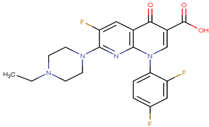 |
| 3FQ | 7-(4-aminopiperidin-1-yl)-1-(2,4-difluorophenyl)-6-fluoro-4-oxo-1,4-dihydro-1,8-naphthyridine-3-carboxylic acid | 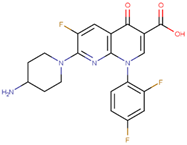 |
| 4FQ | 1-(6-amino-3,5-difluoropyridin-2-yl)-7-[(1R,5S,6R)-6-amino-3-azabicyclo [3.1.0]hexan-3-yl]-6-fluoro-4-oxo-1,4-dihydro-1,8-naphthyridine-3-carboxylic acid |  |
| 5FQ | 1-(2,4-difluorophenyl)-6-fluoro-7-(3-hydroxyazetidin-1-yl)-4-oxo-1,4-dihydro-1,8-naphthyridine-3-carboxylic acid | 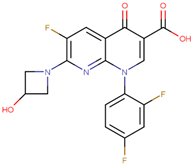 |
| 6FQ | 1-(6-amino-3,5-difluoropyridin-2-yl)-6-fluoro-7-(3-hydroxyazetidin-1-yl)-4-oxo-1,4-dihydro-1,8-naphthyridine-3-carboxylic acid | 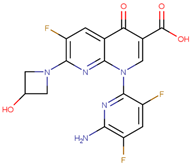 |
| 7FQ | 1-(6-amino-3,5-difluoropyridin-2-yl)-7-[(5S,7S)-7-amino spiro [2.4]heptan-5-yl]-8-chloro-6-fluoro-4-oxo-1,4-dihydroquinoline-3-carboxylic acid | 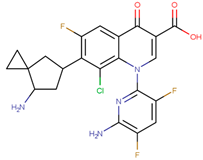 |
| 8FQ | 8-chloro-6-fluoro-1-[(1S,2S)-2-fluorocyclopropyl]-7-(3-hydroxyazetidin-1-yl)-4-oxo-1,4-dihydroquinoline-3-carboxylic acid | 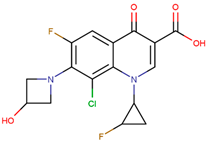 |
| 9FQ | 7-[(7R)-7-amino-5-azaspiro[2.4]heptan-5-yl]-6-fluoro-1-[(1S,2S)-2-fluorocyclopropyl]-4-oxo-1,4-dihydro-1,8-naphthyridine-3-carboxylic acid |  |
| Microorganism | GyrA | GyrB |
|---|---|---|
| Staphylococcus aureus | Q99XG5 | P66937 |
| Campylobacter jejuni | Q03470 | O87667 |
| Escherichia coli | P0AES4 | P0AES6 |
| Neisseria gonorrhoeae | P48371 | P22118 |
| Pseudomonas aeruginosa | P48372 | Q9I7C2 |
| Salmonella typhi | P37411 | P0A2I4 |
Disclaimer/Publisher’s Note: The statements, opinions and data contained in all publications are solely those of the individual author(s) and contributor(s) and not of MDPI and/or the editor(s). MDPI and/or the editor(s) disclaim responsibility for any injury to people or property resulting from any ideas, methods, instructions or products referred to in the content. |
© 2023 by the authors. Licensee MDPI, Basel, Switzerland. This article is an open access article distributed under the terms and conditions of the Creative Commons Attribution (CC BY) license (https://creativecommons.org/licenses/by/4.0/).
Share and Cite
Coba-Males, M.A.; Lavecchia, M.J.; Alcívar-León, C.D.; Santamaría-Aguirre, J. Novel Fluoroquinolones with Possible Antibacterial Activity in Gram-Negative Resistant Pathogens: In Silico Drug Discovery. Molecules 2023, 28, 6929. https://doi.org/10.3390/molecules28196929
Coba-Males MA, Lavecchia MJ, Alcívar-León CD, Santamaría-Aguirre J. Novel Fluoroquinolones with Possible Antibacterial Activity in Gram-Negative Resistant Pathogens: In Silico Drug Discovery. Molecules. 2023; 28(19):6929. https://doi.org/10.3390/molecules28196929
Chicago/Turabian StyleCoba-Males, Manuel Alejandro, Martin J. Lavecchia, Christian David Alcívar-León, and Javier Santamaría-Aguirre. 2023. "Novel Fluoroquinolones with Possible Antibacterial Activity in Gram-Negative Resistant Pathogens: In Silico Drug Discovery" Molecules 28, no. 19: 6929. https://doi.org/10.3390/molecules28196929
APA StyleCoba-Males, M. A., Lavecchia, M. J., Alcívar-León, C. D., & Santamaría-Aguirre, J. (2023). Novel Fluoroquinolones with Possible Antibacterial Activity in Gram-Negative Resistant Pathogens: In Silico Drug Discovery. Molecules, 28(19), 6929. https://doi.org/10.3390/molecules28196929










